

|
Soundclip:
|
| See Steve's Hand-Written Solo
Transcription |
|
Steve Khan's acoustic guitar solo on: "Huracán Clare"(Jorge Estrada) How Jorge Estrada's fantastic tune, "Huracán Clare" came to be a part of this album is quite a story, and, in truth, a most unusual story. Over the course of my life, my life as a musician and recording artist, I have had some interesting ideas and concepts, often when it has come to working with other artists, and hoping to do something together that is mutually beneficial - artistically speaking! Of all of those ideas and concepts, this is the only one that has worked out.  In the past, when I have suggested something or offered something, not one person has ever taken me up on it. So, with that said, here's the story as best as I can recall the details. In the past, when I have suggested something or offered something, not one person has ever taken me up on it. So, with that said, here's the story as best as I can recall the details.In 2013, yes, some 6 years ago, bassist Jimmy Haslip contacted me to see if I wanted to be a part of a tune that was dedicated to one of my harmonic heroes, the great Clare Fischer. Truth be told, I was most skeptical at first, because there are those who think that they are really into Clare's harmonic or compositional style - but then, it usually turns out that they are not even close. But that aside, and trying to have some faith, I asked Jimmy to send me the demo of the track. When I first heard keyboardist Jorge Estrada's song, I was completely knocked out, and I said to myself, "This guy really gets it! He understands!!!" And, beyond that, I called Jimmy immediately, and said that I wanted to be a part of the tune. So much so that I paid for myself to go into a small studio, Eastside Sound, here in New York, with engineer, Fran Cathcart, and not only recorded myself on my nylon-string guitar, but I heard that some vocalese, doubling certain lines, would add just the right touch to the piece, and would bring together Clare's Latin influences with his love of Brasilian music. What made things a bit difficult and even crazy in a way was that, I only had Jorge's 2-track demo to play to - that was it. There was no way to really make a great headphone mix to play to - so it was not easy. When I was done, and Fran and I had a decent sounding rough mix, I closed my eyes and courageously sent it to Jorge, whom I had never met or spoken to, and just hoped that he would like what I had done, and that he might even use it as his own recording continued to take shape and grow. Lucky for me, when Jorge heard what I had done, he was thrilled, and I felt that one day, I would be part of a great, great tune. However, time passed, and time continued to pass. Weeks became months, and months suddenly seemed to turn into years, and each time that I spoke to Jimmy, he had no real news to tell me about Jorge's progress with his album. As 2018 was fully in bloom, Jorge still had no finished album, and certainly nothing to release. 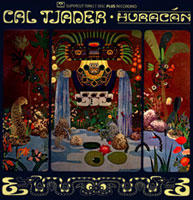 As I prepared to record an album of my own, I came-up with the rather crazy idea that I would offer Jorge that I would record the tune as I heard it, leaving all of his principal parts there, but performing it with our rhythm team here in New York. I don't know that I've ever heard such a story before. But Jorge actually liked the idea, sent me the files, and here we are! He actually wrote to me: "You actually like my song that much?!?!?!" And I wrote him back, "Yes, absolutely! I think that it is a great piece of music, and it deserves to be finished, and have a chance at being heard." As I prepared to record an album of my own, I came-up with the rather crazy idea that I would offer Jorge that I would record the tune as I heard it, leaving all of his principal parts there, but performing it with our rhythm team here in New York. I don't know that I've ever heard such a story before. But Jorge actually liked the idea, sent me the files, and here we are! He actually wrote to me: "You actually like my song that much?!?!?!" And I wrote him back, "Yes, absolutely! I think that it is a great piece of music, and it deserves to be finished, and have a chance at being heard."In addition to Jorge's great Rhodes solo, there is an incredible quinto solo from our beloved and fiery Bobby Allende. The feel, the intense energy from Rubén Rodríguez, this time on 5-string electric bass, Marc Quiñones on timbal, bongó, campana, güiro and maracas, and the immense presence of dear Dennis Chambers makes "Huracán Clare" simply wall-to-wall energy from start to finish. On Jorge's original demo, the entire piece, except for the rubato sections at the top and in the middle, was played as a songo, but when Marc got his hands on the tune at rehearsal and at the session in March of 2019, it was mostly played as a son montuno. I think that we're only playing songo behind Bobby's solo. Because of all of the combustible fire and energy emanating from the grooves of this song, it would certainly make it a candidate for opening any album. 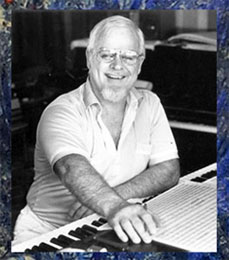 But, as I am fundamentally an electric guitar player, and here I am playing nylon-string acoustic, coupled with the fact that this tune opens with a vocalese section, my feeling was that it really did not represent what the music was to be for the album as a whole. After carefully considering all of the various options, I felt that the best placement for it in the sequence was to be the album's closer - and that's where you're going to find it. I am so proud that this wonderful song graces this recording. Thank you so much Jorge for your faith and confidence in me - in all of us! But, as I am fundamentally an electric guitar player, and here I am playing nylon-string acoustic, coupled with the fact that this tune opens with a vocalese section, my feeling was that it really did not represent what the music was to be for the album as a whole. After carefully considering all of the various options, I felt that the best placement for it in the sequence was to be the album's closer - and that's where you're going to find it. I am so proud that this wonderful song graces this recording. Thank you so much Jorge for your faith and confidence in me - in all of us!For those of us who are huge Clare Fischer fans, the title, "Huracán Clare" has to come from one place, and that is from a song of Clare's that is titled "Huracán" and first appeared, I believe, on a live album of Cal Tjader's from ca. 1978. The album features some of my favorite Clare Fischer tunes including "Bachi" and "Novios" in addition to having a rhythm section of: Willie Bobo(timbal), Poncho Sánchez(conga), and Victor Pantoja(bongó). The tune "Huracán" has stayed with me all of these years because of one chord sonority/voicing! It appears on the and-of-2 in bar 4 of the tune, and is characterized by a small collection of widely spaced 2nds. Spelling up you have: E-F, B-C#, G-A - all above middle 'C' - and the tonal center is 'D'! You could say that this is really Dm6/9sus(maj7). Almost everything is in there, but what a sound it makes. I have gone on to use my own versions of this sonority on several arrangements of my own - and I would never be ashamed to admit that! Before I had even attempted to record myself on "Huracán Clare," I first had to transcribe it from a melodic and structural standpoint. It seemed to be so complex when I was just a listener. There were only two spots where I felt that there was some kind of an opportunity for an acoustic guitar solo, 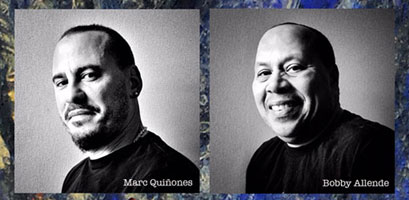 and I chose acoustic guitar, because I felt that an electric guitar sound would have a tough time competing for sonic space with Jorge's wonderful Rhodes-esque/Clare-esque sound. Though it's a little odd perhaps, but there are two 16-bar solo sections, which I labeled as letter [D] and [D2]. Both of these sections follow the letter [C] sections (Duh!) that feature Rubén's awesome thunder-thumbs bass playing. 16-bars doesn't seem like much at a brisk tempo like this one, and when the music is written in cut-time. But, as I have said from the outset, just being a part of such a great composition is more than enough for me! You can feel and hear just how into it Marc, Bobby and Dennis were - their playing is so forceful and creative. Listen to Bobby playing the fast melody passages on his conga, or Mark making the hits just after that on bongó. And listen to how all 3 of them are so responsive during Jorge's great solo. In the end, this performance is really something to be proud of. and I chose acoustic guitar, because I felt that an electric guitar sound would have a tough time competing for sonic space with Jorge's wonderful Rhodes-esque/Clare-esque sound. Though it's a little odd perhaps, but there are two 16-bar solo sections, which I labeled as letter [D] and [D2]. Both of these sections follow the letter [C] sections (Duh!) that feature Rubén's awesome thunder-thumbs bass playing. 16-bars doesn't seem like much at a brisk tempo like this one, and when the music is written in cut-time. But, as I have said from the outset, just being a part of such a great composition is more than enough for me! You can feel and hear just how into it Marc, Bobby and Dennis were - their playing is so forceful and creative. Listen to Bobby playing the fast melody passages on his conga, or Mark making the hits just after that on bongó. And listen to how all 3 of them are so responsive during Jorge's great solo. In the end, this performance is really something to be proud of.As the 1st guitar solo section [D] arrives, the band observes some basic dynamics, and comes down for the nylon-string. One other really nice touch is that Jorge plays beautiful long chords behind me, which made this an appealing spot for a solo, and gave me much more of a full range of expression. For this section, which certainly contrasts to all the chordal activity that has come before it, I am just playing over 2 bars of Em7(9) and 2 bars of Cmaj7(#11). To my ears, there really isn't one modal solution to a vamp or chord progression like this. If you chose to play E Dorian over both, the solution would be to generally avoid C-naturals or C#'s. If you chose to look at it as C Lydian, you would certainly want to avoid those C-naturals over the Em7 chord. It doesn't mean that you can't play those notes as passing tones or as a neighboring tone that goes by quickly, but if you played with a 'normal' modal approach, you would surely hear that something didn't sound right. So, knowing these things, to me the best options would be E minor pentatonic [E, G, A, B, D] and/or B minor pentatonic [B, D, E, F#, A]. Obviously both do not contain a C-natural or C#. | Em7(9sus) / / / | / / / / | Cmaj7 / / / | / / / / :|| Looking at what I played in those first 8 bars, it seems that, after allowing the section to breath for a moment, I played a motif in E minor pentatonic and, as the Cmaj7 chord arrived, I quickly shifted to B minor pentatonic. In bar 5, 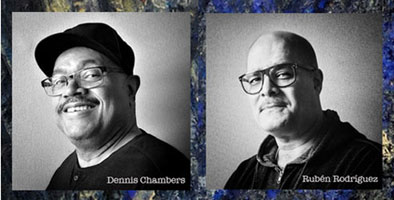 the E-F#-A that I played could be viewed as that I just stayed on B minor pentatonic over the Em7. From there, a lot of chromaticism enters with the next line, and it seems to me that it is just a way of making something chromatic out of B minor pentatonic. When I look at my own transcription, it is interesting to note that in bars 1, 5, 9 and 13, I began each phrase in the 2nd-half of the bar. The phrase leading into those bars ended on beat 4 with 2 8th-notes phrased long-short! In bars 9-11, I continue using B minor pentatonic, and this phrase ends in bar 12 with a double-stop blues lick with a high-E against the moving notes below. Notice the blue note Bb. In bars 13-15, the chromaticism returns, and I still hear it as being connected to B minor pentatonic. The last phrase employs a different way of playing double-stops, this time holding a B-natural over the moving line below. It all ends with two intervals in 6ths, as I cadence with the top notes D# to E, and the arrival of Jorge's montuno and letter [E] for Bobby's tremendous quinto solo. the E-F#-A that I played could be viewed as that I just stayed on B minor pentatonic over the Em7. From there, a lot of chromaticism enters with the next line, and it seems to me that it is just a way of making something chromatic out of B minor pentatonic. When I look at my own transcription, it is interesting to note that in bars 1, 5, 9 and 13, I began each phrase in the 2nd-half of the bar. The phrase leading into those bars ended on beat 4 with 2 8th-notes phrased long-short! In bars 9-11, I continue using B minor pentatonic, and this phrase ends in bar 12 with a double-stop blues lick with a high-E against the moving notes below. Notice the blue note Bb. In bars 13-15, the chromaticism returns, and I still hear it as being connected to B minor pentatonic. The last phrase employs a different way of playing double-stops, this time holding a B-natural over the moving line below. It all ends with two intervals in 6ths, as I cadence with the top notes D# to E, and the arrival of Jorge's montuno and letter [E] for Bobby's tremendous quinto solo.After Bobby's solo, the tune returns to a 2nd rubato section, which I labeled as [I2] with an extra 4-bars for the transition [I3]. Then, it is back to tempo for Jorge's solo at [F], and eventually, we D.S. back to the main melody. We follow this through, but this time we take a 2nd Ending, and move more quickly to [C] and [D2] for the 2nd acoustic guitar solo, or interlude. If you're listening to the soundclip that I have provided, both solo sections are included in the same clip, I just faded it out at Bobby's solo, and then faded it back in as the reprise of letter [C2] begins. So don't worry, everything is there. Here, thanks to the cutaway on my Yamaha APX-10N nylon-string, I begin this solo section in my upper register, and between engineers Fran Cathcart and James Farber, they were able to make me sound like something. As for the 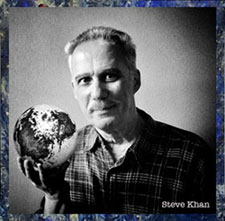 opening phrases, even though there are F#'s present, this feels more like E minor pentatonic to me in bars 1-4. In bars 5-8, there is a nice motivic sequence which I would describe as a mixture of both E minor pentatonic (in bar 5) and B minor pentatonic (bars 6-8). In bar 9, more of a Jazz sensibility is employed by using the D#(maj7th) amidst some chromaticism, but do notice that neither C nor C# is ever touched upon! In bars 11-12, even with the presence of an F# and further chromaticism, I would still see this as being fundamentally E minor pentatonic. In bar 14, leading into the last 2 bars of Cmaj7, this is something that I really like the sound of, as here I am playing a C triad (E-G-C-E) in an anticipation of the arrival of Cmaj7, and it is really the only moment in either of these brief solos where I could say that this feels more like C Lydian [C, D, E, F#, G, A, B] to me. The solo ends on beat 3 of bar 16, which gives us all a brief breath before Jorge's fantastic [Tag] arrives to drive "Huracán Clare" to its conclusion. These final six 4-bar phrases offer great lines, fantastic harmony à la Clare, and truly great keyboard playing from Jorge Estrada. I really do hope that everyone will look into accessing the full version, and enjoy this wonderful composition. Believe me, I only wish that I could have written something like this!!! That would have really been great! opening phrases, even though there are F#'s present, this feels more like E minor pentatonic to me in bars 1-4. In bars 5-8, there is a nice motivic sequence which I would describe as a mixture of both E minor pentatonic (in bar 5) and B minor pentatonic (bars 6-8). In bar 9, more of a Jazz sensibility is employed by using the D#(maj7th) amidst some chromaticism, but do notice that neither C nor C# is ever touched upon! In bars 11-12, even with the presence of an F# and further chromaticism, I would still see this as being fundamentally E minor pentatonic. In bar 14, leading into the last 2 bars of Cmaj7, this is something that I really like the sound of, as here I am playing a C triad (E-G-C-E) in an anticipation of the arrival of Cmaj7, and it is really the only moment in either of these brief solos where I could say that this feels more like C Lydian [C, D, E, F#, G, A, B] to me. The solo ends on beat 3 of bar 16, which gives us all a brief breath before Jorge's fantastic [Tag] arrives to drive "Huracán Clare" to its conclusion. These final six 4-bar phrases offer great lines, fantastic harmony à la Clare, and truly great keyboard playing from Jorge Estrada. I really do hope that everyone will look into accessing the full version, and enjoy this wonderful composition. Believe me, I only wish that I could have written something like this!!! That would have really been great!I suppose I should say a word or two about my adventures in vocalese on this particular tune which, though very singable in a certain sense, I would hardly say that I am the ideal candidate to be doing this. But sometimes, when singing alone at home with the track, one can fool oneself into actually believing that they sound pretty good, and that, of all things, here, I could do it. So, in an act of complete and total blind faith - knowing that, no matter what the result, Rob Mounsey, during post-production, could always help me out with touches of Melodyne as needed. So, I doubled my parts, and just hoped for the best. Honestly, if this is saying anything, I didn't sound too bad without any technological help - but, I would be the first to admit, that these vocals sound amazingly better, though never unnatural, with said "help." In this age, our present age, one has to decide what side of the fine line to walk, and how far to go in the service of the music. In the end, for me, I just want to do what is right for the song, to make it sound and feel as good as it can, and I'm not going to beat myself up too much over the aesthetics of another time - even though I am very much a product of that time - and, I very much believe in those ideals. But not to take advantage of what is now available is foolish. I hope that those of you who still actually read webpages have enjoyed this particular story, and maybe even found it to be inspiring. Sometimes in life, there can be interesting, if unusual, solutions to issues or problems that don't seem to have one. I don't think that I mentioned it before but, Jorge Estrada is from Guadalajara, Jalisco, México. In this case, my sincere belief in Jorge's song, "Huracán Clare" caused me to reach out to him, and try to find a way, whereby he could end-up getting his song recorded and released on an actual CD, and I could, by virtue of that, have this fantastic piece of music - and the performances that came with it become an important part of "PATCHWORK." The great adventure that is making a recording is filled with unknowns and uncertainties, not the least of which would be, "What will happen when the album is released to the public? Will anyone get to hear it? Will anyone be touched or reached by the music?" These are questions that are often not easily answered. As I am not the most actively engaged social media person, I do rely on this website, and sometimes Facebook, to hear from friends and fans alike, and when I do hear from people about one of the recordings, it really does mean a lot to me. I am going to hope that Jorge hears from people too - that would be a most rewarding result. Since the release of the album during September of 2019, one of the most rewarding things has been the reception at Jazz radio across the USA. And, as part of that embracing of the music, it has turned out that "Huracán Clare" became one of the tunes that was played quite often, and not just on the specific Latin Jazz shows that populate some of the larger stations across the country. It serves to demonstrate that, no matter where you might place a tune in the CD sequence, DJs and sometimes music directors are going to find that piece of music and present it no mater what! Closing the album with this tune was never ever a statement on the value of the music or the performance. Sequencing an album is just that - it is seeing the entire collection of music as one piece of work - even if NO ONE ever listens to it that way!!!
[Photos: Jorge Estrada
Clare Fischer Marc Quiñones & Bobby Allende @ Sear Sound by Richard Laird Dennis Chambers & Rubén Rodríguez @ Sear Sound by Richard Laird Steve Khan with the Michel Granger Globe @ Sear Sound by Richard Laird] |